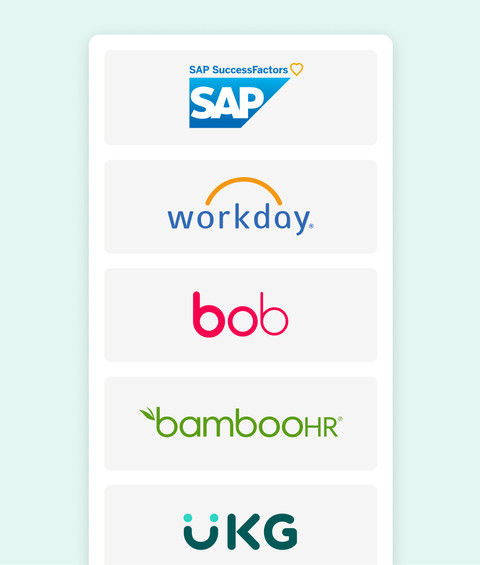.jpg)
The top four HRIS features for data security & fraud prevention



A Human Resources Information System (HRIS) is a software superhero for HR teams (and a valuable sidekick for finance). HR tools and systems simplify and automate HR management, providing real-time data insights and turbocharging productivity. They also help protect sensitive employee information from external and internal threats. Think you’ve got the right and most secure HRIS in place? Find out what you should expect.
By submitting this form, you agree to receive emails about our products and services per our Privacy Policy.
Although most employees wouldn’t dream of running a fraud scheme within your organization, unfortunately, some will. People inside organizations commit 37% of fraud, and the average employee fraud scheme runs over 24 months, with a loss of $31,000.
Threat-acting employees can run scams they’ve planned for years, siphoning off small amounts of money and using receipts to their advantage. These small amounts slowly add up to thousands of lost pounds without anyone noticing.
The importance of an HRIS in fraud and security prevention
Consider all the data you keep on your employees — their home addresses, bank details, financial information, etc. An HRIS houses a lot of sensitive data like this — and unfortunately, it's a magnet for malicious actors. If they get their hands on it, they can sell and use it to their advantage, costing your organization thousands to repair the damage.
That's why you must keep your HRIS under digital lock and key, implementing robust security measures like data encryption and multi-factor authentication to protect every bit of information you store.
But remember, it's not just your HRIS that stores employee data. Systems, including your ERP and CRM, also store this information. So, you must choose software systems with reliable integrations to ensure all your data stays secure.

The benefits of implementing an HRIS
An HRIS simplifies HR tasks from recruitment and performance management to learning and development. It also centralizes and protects employee data, keeping it safe and secure from internal or external threats.
There are further benefits, too; here are five of the most important, according to Shortlister:
- Automation of HR roles: Manual data entry drains unnecessary resources. An HRIS can automate your entire recruitment and onboarding process through to your payroll, training, and development processes.
- Improved data storage and security: Using an HRIS system ensures that any data you enter lies within local legal requirements. It also helps with accurate record-keeping, data retention, and privacy.
- Centralised employee data: Real-time access to centralized data means anyone with the right-level access can make decisions based on up-to-date information.
- Easier on and offboarding: In terms of security, offboarding is the priority. For example, if an employee no longer works in your company, you must offboard them immediately. By using an HRIS, you can remove the employee and their associated access, i.e., revoking their login details, so they can't use their knowledge of your systems to carry out fraudulent activities.
- Higher report accuracy and improved oversight: Designated people across HR, finance, and accounting can access accurate financial information about employee salaries, which means teams can benchmark against industry averages, establish fair pay, and improve overall operational efficiency.
The security risks of improper employee offboarding and how to prevent it
If you don’t properly offboard your employees, you leave your organization open to significant security risks. These ex-employees have passwords, and they know your organizational processes, the systems you use, and how to access them. With this unauthorized access, ex-employees can easily steal sensitive information, leading to data breaches and compliance violations.
Employee offboarding best practices
Firstly, conduct your offboarding interview fairly and leave your relationship in the best position possible. Aside from this, what else can you do?
- In their exit interview, listen to employees and understand their reasons for leaving (or elaborate on reasons for being terminated). Can you improve the employee experience to retain current employees? Don’t just dismiss their choice to leave your organization or understand the events leading to their dismissal.
- Offboard the employee from all systems. Revoke access to all company information as soon as possible and collect all company property from them, i.e. company laptop and mobile phone. Pro tip: Instil an offboarding policy for all managers to follow once an employee leaves.
- Communicate their departure across departments so they can identify any other system access the employee might have.
- Check all the systems and ensure that all access has been revoked
By following these simple steps, you can reduce any threats ex-employees pose to your organization. By conducting exit interviews, you can identify why people are leaving the company, allowing you to address them before you lose any more talent. They also offer an opportunity to determine the events leading up to an employee’s dismissal.
Key features of HRIS systems for fraud prevention
Safeguarding your employee data is critical to prevent fraudulent activities.
According to our research and experience, some of the key fraud prevention features of a robust HRIS system include:
Role-based access controls
These access controls restrict users based on their level of authority. I.e., HR managers will need extensive access, the ability to create and remove users, edit information, etc. However, non-HR employees will not need this level of access. Implementing tiered access controls helps minimize data risk and threats.
Multi-factor authentication
Multi-factor authentication (MFA) is an effective way to verify user identity and reduce the threat of malicious actors. There are several authentication methods, including SMS, emails, and authenticator apps. Two-factor authentication requires all users to provide two forms of identity: a username and password and a unique identifier code generated by an authenticator app.
Automated audit trails
HRIS platforms have to record user activity, and these logs maintain details like transaction history, access to datasets, revision history, IP address, and more. This transparency means users are held accountable for their actions; no one can make amends without others knowing who has made them. This reduces the likelihood of employee fraud and makes it much easier to identify suspicious activity.
Reporting and analytics
Sophisticated reporting in modern HRIS platforms learns and identifies fraudulent patterns automatically. They can raise the alarm if employee records don’t match, are incomplete and therefore non-compliant, or if data quality issues like duplicate records or someone has entered incorrect compensation data.
Best practices for fraud prevention with an HRIS
Find a secure HRIS platform
Before you start assessing your options, holistically evaluate your organizational needs. What are your growth plans? What degree of flexibility do you need in this new system? If you already have an HRIS, why aren’t you happy with it? What features or functionality is it missing?
Once you know what you’re looking for, you’ll find it much easier to whittle down your system shortlist. Then, approach your options, ask for product demonstrations, and share your needs and business challenges.
Implement secure authentication and encrypt your data
Implementing authentication processes to allow user access is key to keeping user accounts secure. Multi-factor authentication puts major roadblocks in front of malicious actors, making it extremely difficult for them to access your accounts, even if they have the correct password or username. This authentication process also helps keep ex-employees from re-accessing systems.
Ensure your vendor encrypts data in rest and transit to protect it fully. Encrypting data protects your data against unauthorized access or data leakage. Even if threat actors intercept this data, they won’t be able to access it.
Training employees helps prevent fraud
A big part of reducing fraudulent activity is training your employees to keep the platform secure and raise flags if they spot anything suspicious. Equip your employees with the knowledge they need to identify different types of fraud, how to report it, and to whom they should report it.
Keep training consistent. When a new threat or scam shows itself in the industry, or if you get another email from the Nigerian prince, take time to educate employees on tackling such issues when they arise. Keeping training up-to-date will help you continue eliminating fraudulent behaviors as they occur and encourage an organization-wide proactive approach to data breach protection.
Integrate your entire tech stack, including spend management
Whichever HRIS platform you choose should be able to integrate perfectly into your tech stack, including your spend management platform. HRIS integrations should add value to your business operations, making them time efficient, enhancing productivity, and increasing data visibility and accuracy.
At Payhawk, we connect to over 55 HRIS providers, simplifying onboarding, automating data synchronization, and reducing fraudulent activities.
- Reimburse employees quicker with HRIS integration
By integrating our solution with your HRIS, your employee bank details can be pulled instantly from one to the other, making reimbursements quicker and more efficient for finance teams and improving employee experience. - Maps all employees, teams, and your organizational structure in a few clicks
It doesn’t matter how complex your expense approval process is; with Payhawk, you can create custom approval workflows for specific expense types, different teams and even individual team members. You can eliminate any delays and gaps with push notifications through the Payhawk app. - Digital expense management removes manual data errors
At Payhawk, our expense management features improve employee reimbursement and digital expense submissions, including OCR technology receipt scanning, which means expenses are automatically captured and reconciled.
By using our solution, you can also centralize spend control and visibility, standardize global expense settings and build group-level workflows, and apply them across multiple entities. Our solution is a complete, international, secure spend control platform — perfect for your HRIS.
Learn more about our market-leading integrations here.
Meet Yana, a seasoned Payhawk veteran and the pioneer of our People team. Yana laid the groundwork for our TA, People Partnering, Employer Branding, and People Ops functions. As our VP of People, she’s the driving force behind a high-performance, people-first culture - obsessed with spotting and retaining top 1% talent, building resilient teams, and embedding people practices that truly move the business forward. She’s a true partner to our leaders, shaping Payhawk’s growth through enabling people strategies. And when she’s not keeping our HR game strong? She’s exploring new countries, food, and cultures.
Related Articles
.jpg)

Prioritising security in 2024: Why 2FA is vital for breach prevention

